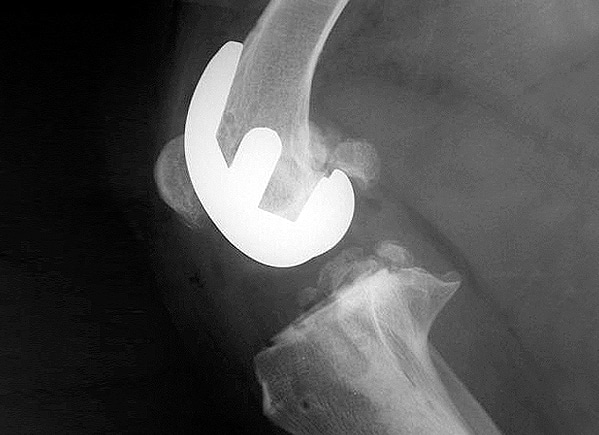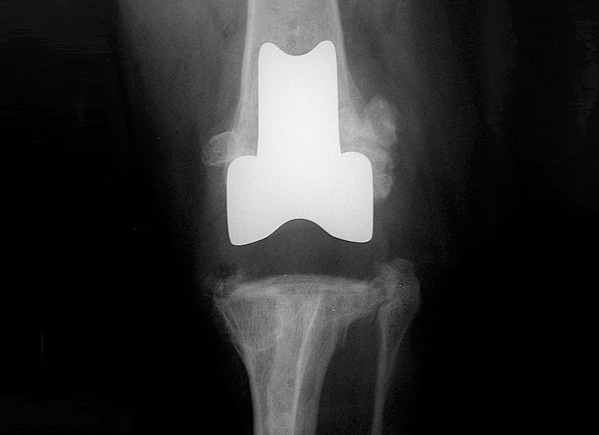
Does my dog need a total knee replacement?
Total knee replacement (TKR) surgery is a major procedure with possible complications. As a result it is only performed in dogs where the benefits of surgery outweigh the possible risks and where alternative methods of treatment are less successful.
TKR surgery is primarily performed in medium and large dogs. Candidates for surgery are dogs with persistently painful knees (stifles) that are not responding satisfactorily to medical management. Signs of knee pain include lameness, stiffness, difficulty rising, difficulty jumping, restlessness and reluctance to exercise and play.
The most common cause of knee joint pain is osteoarthritis associated with rupture of the cranial cruciate ligament. (See also Cranial Cruciate Ligament Rupture Information Sheet)
Are there any contraindications to TKR surgery?
Dogs with knee osteoarthritis, no matter how severe, are not candidates for TKR surgery if signs of pain and lameness are mild and readily controlled by conservative measures.
Candidates for TKR surgery must be in good general health. Blood tests may be recommended to ensure that internal organs, for example the liver and kidneys, are working properly and that the blood cells are normal.
It is important that the dog has no general infections, for example of the skin (pyoderma), and that the knee joint to be replaced is not infected. If there is any doubt regarding the latter it may be necessary to collect a sample of fluid from the joint and send it to a laboratory for analysis.
What does TKR surgery involve?
Dogs have to be evaluated to see if they are a suitable candidate for TKR surgery. This is done on a separate day to the surgery; often a few weeks before. The first step is to ‘measure’ the patient for the prostheses. This requires obtaining very specific X-rays (radiographs) of the knee and placing them against line drawings (templates) of the various sizes of prostheses available.
Your dog will usually be admitted the day before the surgery. He or she may be fed that morning and water should not be withheld.
The surgery
Joint replacements are amongst the most challenging operations performed by veterinary orthopaedic surgeons. A team of two surgeons and a nurse are involved. The operating theatre and a vast array of surgical instruments are prepared the day before.
The operation is performed through an incision directly over the front of the knee. Careful preparation of the two bones that make up the knee (the femur and tibia) is necessary prior to placement of the relevant prostheses. The two artificial components are then brought together (reduced) and the stability of the knee checked. The capsule that surrounds the joint is carefully stitched (sutured) prior to closure of the rest of the wound.
Radiographs are obtained at the end of the operation to check the position of the prostheses.

X-rays showing a total knee replacement
Aftercare
Aftercare following TKR surgery is very important with rehabilitation taking many months. Courses of painkillers and antibiotics are prescribed at discharge. If your dog tends to excessively lick the wound it may be necessary to use a plastic Elizabethan collar. Visits to your own veterinary surgeon are necessary within the first two weeks to check the wound.
Exercise must be very restricted for the first few weeks until the joint capsule and other soft tissues heal. This is the period when dislocation (luxation) of the prostheses is most likely. Exercise is primarily for toileting purposes. It must be on a lead or harness to prevent strenuous activity, such as chasing a cat or squirrel. At other times confinement to a pen or a small room in the house is necessary with avoidance of jumping and climbing. After a few weeks, exercise may be gradually increased in a controlled manner (still on a lead). Physiotherapy and hydrotherapy are important aspects of postoperative care.
The first check-up is two weeks after the operation. Limb and knee function are evaluated at this time. Depending on progress advice is given regarding increasing exercise. The next check-up is six weeks following surgery when radiographs are obtained to evaluate the TKR. The bone surrounding the prostheses is checked and compared to the radiographs obtained immediately following surgery. This enables stability of the prostheses to be assessed. Further advice is given regarding exercise.
Clinical and radiographic examinations are further recommended depending on progress.
Risks and complications
Total knee replacement surgery is a major procedure. Knee pain is reduced and limb function improved in the majority of dogs. However, there are potential complications including dislocation (luxation), loosening of the prostheses and infection.
Conclusion
Total knee replacement surgery in dogs is undoubtedly a major undertaking, but can be beneficial in certain dogs with chronic knee pain that fails to respond to medical management. We will be pleased to give as much help and support as possible if you decide to give your pet the opportunity of TKR surgery.
If you have any queries or concerns, please do not hesitate to contact us.
Arranging a referral for your pet
If you would like to refer your pet to see one of our Specialists please visit our Arranging a Referral page.
